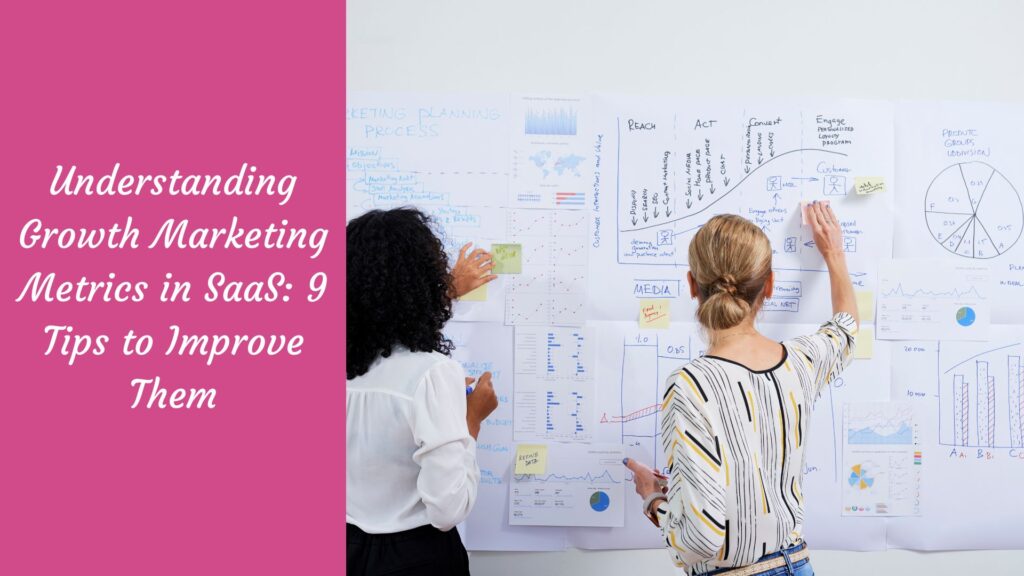As a SaaS owner, you’re well aware that growth is the ultimate yardstick of success. But here’s the question: how do you actually measure and track that growth? Well, buckle up because we’re about to dive into the exciting world of growth marketing metrics. These little nuggets of wisdom will reveal how your business is performing across various areas.
From acquisition to retention, they hold the key to unlocking your growth strategy. So grab a cup of coffee, sit back, and get ready to supercharge your SaaS business with these nine essential growth marketing metrics!
What is Growth Marketing Metrics?
Growth Marketing Metrics, often called Key Performance Indicators (KPIs), are quantifiable measures that businesses use to track, analyze, and guide their growth strategies. These metrics provide insights into different aspects of a business, aiding in making data-backed decisions.

Here are a few examples:
- Customer Acquisition Cost (CAC): This is the total cost of acquiring a new customer, including all advertising, sales, and marketing expenses. For, e.g., if you spend $1000 on marketing in a month and acquire 10 customers, your CAC is $100.
- Lifetime Value (LTV): This predicts the total revenue from a single customer account. For example, if a customer subscribes to your $100/year plan and stays with you for an average of 3 years, the LTV is $300.
- Monthly Recurring Revenue (MRR): It is the predictable monthly revenue a company can expect. For instance, with 50 customers paying $50/month, your MRR is $2500.
- Churn Rate: This is the rate at which customers stop doing business with you over a given period. If you begin with a customer base of 100 and experience a loss of 5 by month-end, your churn rate stands at 5%.
- Net Promoter Score (NPS): This metric gauges customer loyalty and satisfaction. Customers rate their likelihood of recommending your business on a scale from 0 to 10.
The percentage of detractors (rating 0-6) from the percentage of promoters (rating 9-10).
Understanding and monitoring these growth marketing metrics can help SaaS businesses identify strengths, weaknesses, and opportunities in their growth strategy.
How do we measure growth marketing metrics using the pirate metrics framework?
The Pirate Metrics framework, coined by Dave McClure of 500 Startups, is a valuable tool for measuring growth marketing metrics. This framework involves five stages – Acquisition, Activation, Retention, Referral, and Revenue (AARRR).

Here’s how to measure growth marketing metrics using the Pirate Metrics framework:
- Acquisition: This involves determining how users find and visit your site. GA is a crucial tool to use in this stage. For instance, if 200 users visit your website from a Facebook ad, your acquisition from Facebook ads is 200 users.
- Activation: This is when users enjoy their first “happy” experience with your service. You can measure this using tools such as Mixpanel or Kissmetrics to track user actions. For instance, if out of 200 visitors, 50 users sign up for a trial, your activation rate is 25%.
- Retention: This is ensuring that your users come back to use your service after their initial visit. Using cohort analysis in Google Analytics can help measure this. For example, if 40 out of 50 trial users log back into your service the following week, your retention rate is 80%.
- Referral: This is when your users like your product enough to refer it to others. Tools like Referral Sasquatch or ReferralCandy can help measure this. For example, if 10 out of 50 users refer a friend, your referral rate is 20%.
- Revenue: This final metric involves turning those users into paying customers. You can calculate this manually or use a tool like ProfitWell. For example, if 20 out of 50 users end up purchasing a subscription, your revenue conversion rate is 40%.
9 Tips to Improve Growth Marketing Metrics
Here are the 9 key tips to improve GMM:

Monthly Recurring Revenue (MRR)

The most important metric in SaaS is MRR. It’s the predictable revenue stream that helps support the ongoing growth of any SaaS business. Tracking your MRR means that you can focus on optimizing your pricing strategy, increasing sales, and reducing churn. To improve your MRR, you need to focus on converting more trials and acquiring new customers.
Customer Acquisition Cost (CAC)

CAC is the cost of acquiring a new customer divided by the total number of customers acquired. It’s a measure of how much it costs to convince someone to buy your product. To improve your CAC, you need to focus on increasing your conversions and reducing your overall marketing costs.
Conversion Rate

Your conversion rate is the number of people who convert to paying customers. If you’re not optimizing your conversion rate, you’re leaving money on the table. By testing and tweaking your website and marketing efforts, you can increase your conversion rate and turn more visitors into paying customers.
Customer Lifetime Value (CLTV)

CLTV is the total value of a customer throughout their relationship with your business. Focus on CLTV to identify valuable customers and optimize marketing efforts towards them.
Churn

Churn is the percentage of customers who cancel their subscription with your business. It’s a critical metric because it measures the health of your business. High churn rates can indicate a problem with your product, pricing, or customer service. By addressing the reasons behind the churn, you can reduce it and improve your overall growth rate.
Net Promoter Score (NPS)

NPS measures how likely your customers are to recommend your product to others. It’s a reflection of how well your product is meeting the needs of your customers. By focusing on improving your NPS, you can increase customer loyalty and drive more organic growth.
Activation Rate

Activation rate is the measure of how many new customers successfully begin using your product. It’s a critical metric because it measures the effectiveness of your onboarding process. By improving your activation rate, you can retain more customers and increase your MRR.
Average Revenue Per User (ARPU)

ARPU is the total revenue divided by the total number of customers. It’s important to measure because it shows how much value you’re delivering to your customers. By making sure your customers are getting the most value from your product, you can increase ARPU and drive more growth.
Time to Value (TTV)

TTV is the measure of how long it takes for a customer to see the value in your product. If it takes too long, customers are more likely to churn. By focusing on reducing your TTV, you can increase customer satisfaction and drive more growth.
FAQs
What is product-led growth?
- Product-led growth (PLG) is a business methodology where the product itself is the primary vehicle driving customer acquisition, conversion, and expansion. For example, popular software companies like Slack and Zoom operate on a PLG model. They offer a free or freemium version of their product, which customers can start using without a sales representative.
- With PLG, the focus is on providing value to the user from their first interaction with the product. Take Dropbox, for example. Users quickly understand its value as it solves the problem of file storage and sharing, leading to increased adoption and growth.
- Finally, PLG is characterized by viral growth driven by network effects. A great example here would be the graphic design tool Canva. As users create and share their designs on social platforms, others get to know about Canva, which leads to more sign-ups and usage, fueling its growth.
How do you measure product-led growth in a SaaS?
- Customer Acquisition Cost (CAC): It is the expenditure involved in convincing potential customers to make a purchase of a product or service. For instance, if a SaaS company invests $1000 on marketing in a year and successfully acquires 1000 customers within the same timeframe, their CAC would be $1.00.
- Lifetime Value (LTV): This metric represents the total revenue a business can reasonably expect from a single customer account. For instance, if a customer subscribes to a $10 per month package and stays for 3 years, their LTV is $360.
- Product Usage: Tracking how frequently and how long customers use your product can show its value. A SaaS company might track daily or monthly active users. For example, Netflix would consider someone who binge-watches shows regularly as a high-value user.
- Net Promoter Score (NPS): This measures customer experience and predicts business growth. A high score means your customers are happy and will promote your SaaS to others. For example, if nine out of ten users said they would recommend your SaaS product, you’d have a high NPS.
- Conversion Rates: Conversions can be measured as the number of trials that convert to paid users or the number of visitors that sign up for a trial. For instance, if 50 out of 200 trial users become paying customers, the trial-to-paid conversion rate is 25%.
What key metrics do you need to track to understand product-led growth?
- Monthly Recurring Revenue (MRR): It measures predictable and recurring revenue components of your subscription business. If you have 10 customers paying $100 each month, your MRR is $1,000.
- Churn Rate: This represents the percentage of subscribers who discontinue their subscriptions within a given period. For instance, if you start your month with a hundred customers and end with ninety, your churn rate is 10%.
- Customer Retention Cost (CRC): This is the cost that a company incurs to keep an existing customer. For example, if you spend $100 a month on customer service for your 100 subscribers, your CRC is $1.
- Customer Engagement: This refers to the degree and depth of brand-consumer relationships and includes metrics like usage frequency, breadth, duration, and intensity. For instance, a music streaming service like Spotify would consider a user who listens to music daily as highly engaged.
- Customer Satisfaction (CSAT): It is used to gauge the happiness level of your customers with your product or services. For example, if, on a survey, 80 out of 100 customers rate their satisfaction as very high, you would have a high CSAT.
What are some tips to improve product-led growth metrics?
- Invest in User Experience: Ensure your product is easy to use and intuitive. For example, simplify the sign-up process and provide a clean, uncluttered user interface. This enhances user satisfaction and can reduce churn.
- Improve Customer Support: Offer quick, helpful responses to customer queries. This could mean expanding your customer service team or investing in automation and AI for faster response times. For instance, companies like Amazon use chatbots to provide instant support.
- Regularly Update Your Product: Keep your product up-to-date with market trends and user needs. A company like Apple frequently updates its devices, ensuring they remain relevant and appealing to users.
- Engage Customers Regularly: Keep in touch with your users through regular newsletters, social media posts, and personalized emails. For example, Netflix sends personalized recommendations to keep users engaged.
- Ask for Feedback: Regularly solicit feedback from your users to understand what they like and what they would change about your product. Companies like Uber often ask for driver and passenger feedback after each ride to improve their service.
- Offer Training and Education: Provide resources like tutorials, webinars, or a knowledge base for customers to better understand and use your product. For example, Adobe offers extensive tutorials on how to use its software.
- Incentivize Referrals: Encourage word-of-mouth marketing by offering incentives for referrals. Dropbox is an excellent example of this, as it rewards users with more storage space for each successful referral.
How can I create a successful product-led growth strategy?
- Understand Your User Persona: Begin by understanding your customer’s needs, pain points, and preferences. This will guide your product development process. For instance, Airbnb understood its user persona and provided a platform for people to rent out their homes, catering to travelers seeking unique and affordable accommodation options.
- Develop a User-Friendly Product: Ensure that your product is intuitive and effortlessly navigable. A prime example of this design philosophy can be seen in Google’s remarkable success. Their straightforward and user-friendly interface has made web searching accessible to individuals from all walks of life.
- Monitor and Iterate Based on User Behavior: Leverage analytics to gain insights into user interactions with your product. This invaluable data allows you to comprehensively understand and optimize user experiences. Take Netflix, for example. They use viewing data to make recommendations and even produce content that their users will enjoy.
- Offer Value from the Start: Your product should provide immediate value to the user. For example, Amazon Prime offers immediate access to a host of benefits, like free two-day shipping and video streaming services.
- Promote Self-Discovery: Encourage users to explore your product independently. Companies like Canva do this well, providing an intuitive design platform that users can easily navigate to create their own designs.
- Leverage Free Trials or Freemium Models: This can encourage users to try the product with no financial risk. Spotify does this effectively by providing a free version of its product while offering premium features for paid users.
- Provide Outstanding Support: Providing an outstanding level of customer service is paramount when it comes to retaining users. Zappos has earned a well-deserved reputation for its exceptional dedication to customer satisfaction, consistently going the extra mile to ensure its customers’ happiness and contentment.
Conclusion
By prioritizing these growth marketing metrics, you can supercharge your SaaS business and ignite unstoppable growth! It’s crucial to truly know your customers, product, and marketing efforts to uncover untapped potential.
Embracing the above tips will not only empower you to track your business’ performance but also revolutionize your growth marketing strategy for an extraordinary future. Let’s soar together! 🚀

